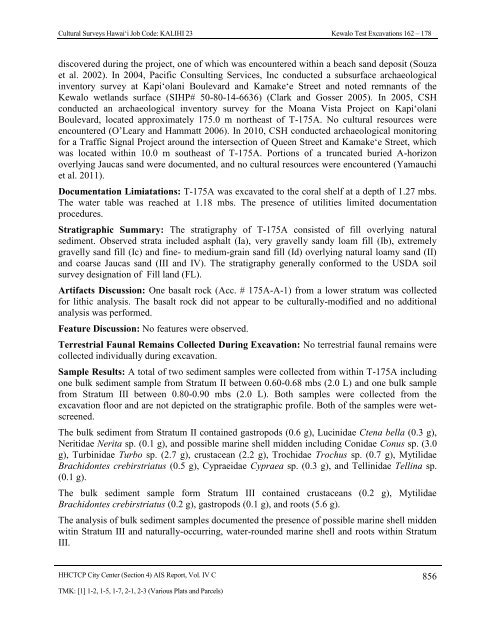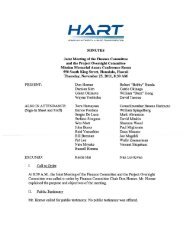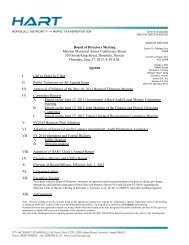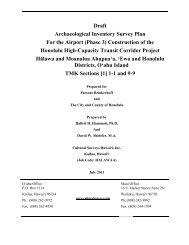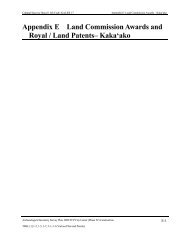4.12 Test Excavation 167 (T-167) - Honolulu Rail Transit Project
4.12 Test Excavation 167 (T-167) - Honolulu Rail Transit Project
4.12 Test Excavation 167 (T-167) - Honolulu Rail Transit Project
Create successful ePaper yourself
Turn your PDF publications into a flip-book with our unique Google optimized e-Paper software.
Cultural Surveys Hawai‘i Job Code: KALIHI 23 Kewalo <strong>Test</strong> <strong>Excavation</strong>s 162 – 178discovered during the project, one of which was encountered within a beach sand deposit (Souzaet al. 2002). In 2004, Pacific Consulting Services, Inc conducted a subsurface archaeologicalinventory survey at Kapi‘olani Boulevard and Kamake‘e Street and noted remnants of theKewalo wetlands surface (SIHP# 50-80-14-6636) (Clark and Gosser 2005). In 2005, CSHconducted an archaeological inventory survey for the Moana Vista <strong>Project</strong> on Kapi‘olaniBoulevard, located approximately 175.0 m northeast of T-175A. No cultural resources wereencountered (O’Leary and Hammatt 2006). In 2010, CSH conducted archaeological monitoringfor a Traffic Signal <strong>Project</strong> around the intersection of Queen Street and Kamake‘e Street, whichwas located within 10.0 m southeast of T-175A. Portions of a truncated buried A-horizonoverlying Jaucas sand were documented, and no cultural resources were encountered (Yamauchiet al. 2011).Documentation Limiatations: T-175A was excavated to the coral shelf at a depth of 1.27 mbs.The water table was reached at 1.18 mbs. The presence of utilities limited documentationprocedures.Stratigraphic Summary: The stratigraphy of T-175A consisted of fill overlying naturalsediment. Observed strata included asphalt (Ia), very gravelly sandy loam fill (Ib), extremelygravelly sand fill (Ic) and fine- to medium-grain sand fill (Id) overlying natural loamy sand (II)and coarse Jaucas sand (III and IV). The stratigraphy generally conformed to the USDA soilsurvey designation of Fill land (FL).Artifacts Discussion: One basalt rock (Acc. # 175A-A-1) from a lower stratum was collectedfor lithic analysis. The basalt rock did not appear to be culturally-modified and no additionalanalysis was performed.Feature Discussion: No features were observed.Terrestrial Faunal Remains Collected During <strong>Excavation</strong>: No terrestrial faunal remains werecollected individually during excavation.Sample Results: A total of two sediment samples were collected from within T-175A includingone bulk sediment sample from Stratum II between 0.60-0.68 mbs (2.0 L) and one bulk samplefrom Stratum III between 0.80-0.90 mbs (2.0 L). Both samples were collected from theexcavation floor and are not depicted on the stratigraphic profile. Both of the samples were wetscreened.The bulk sediment from Stratum II contained gastropods (0.6 g), Lucinidae Ctena bella (0.3 g),Neritidae Nerita sp. (0.1 g), and possible marine shell midden including Conidae Conus sp. (3.0g), Turbinidae Turbo sp. (2.7 g), crustacean (2.2 g), Trochidae Trochus sp. (0.7 g), MytilidaeBrachidontes crebirstriatus (0.5 g), Cypraeidae Cypraea sp. (0.3 g), and Tellinidae Tellina sp.(0.1 g).The bulk sediment sample form Stratum III contained crustaceans (0.2 g), MytilidaeBrachidontes crebirstriatus (0.2 g), gastropods (0.1 g), and roots (5.6 g).The analysis of bulk sediment samples documented the presence of possible marine shell middenwitin Stratum III and naturally-occurring, water-rounded marine shell and roots within StratumIII.HHCTCP City Center (Section 4) AIS Report, Vol. IV C 856TMK: [1] 1-2, 1-5, 1-7, 2-1, 2-3 (Various Plats and Parcels)


